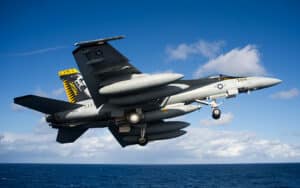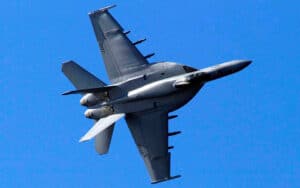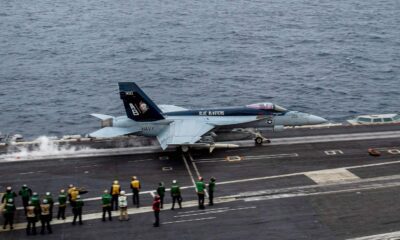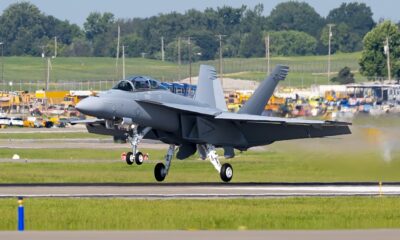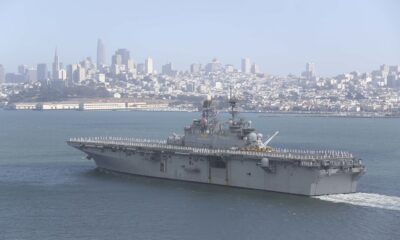Aerospace
Mind blowing facts about US Navy F/A 18 super Hornet fighter jet
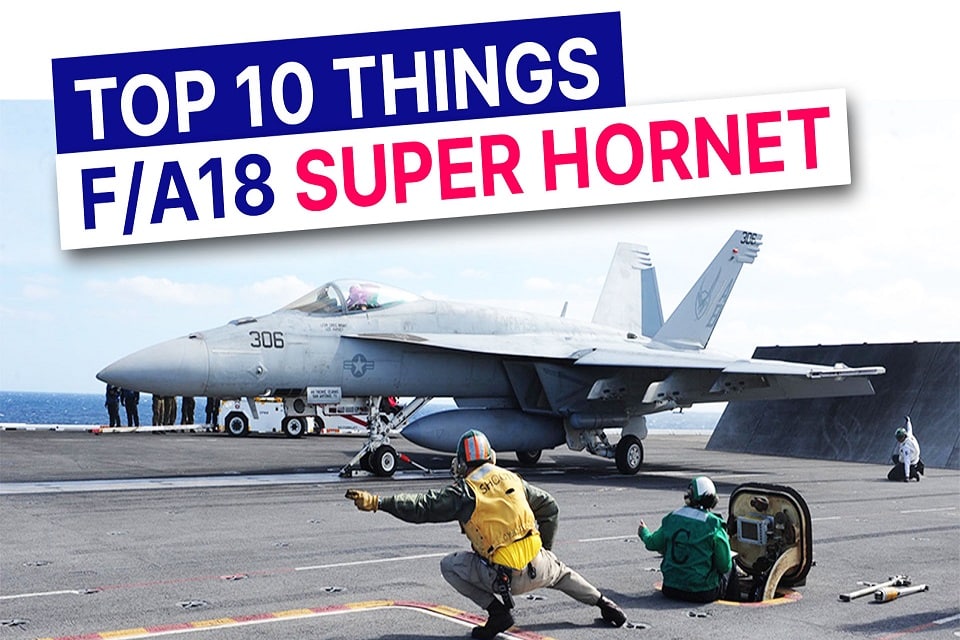
This super Hornet has distinguished itself in combat zones as a deterrent or frontline offence, as well as at home providing security and defense to the United States and other countries, thanks to its proven capabilities. Because there are so many interesting facts about the F/A 18 Super Hornet, we’re looking at things we didn’t know about it.
- It was built in 1978
The Boeing F/A-18 Hornet is a fighter plane that was originally built by McDonnell-Douglas. It flew for the first time in 1978 and was initially introduced in 1983. The United States Navy is its primary customer. Because of its unique design, it can take off from aircraft carriers. The F/A-18 is capable of attacking both land and air targets. “Multi-role” refers to any aircraft that can accomplish this.
2. Air superiority, day/night strike
The F/A-18 Block III, the latest version of the F/A-18, can conduct a variety of tactical tasks including air superiority, day/night strike, and precision guided munitions. The single-seat E model and the two-seat F model of the Super Hornet are capable of performing virtually every tactical mission, including air superiority, day/night strike with precision-guided weapons, fighter escort, close air support, suppression of enemy air defenses, maritime strike, reconnaissance, forward air control, and tanker missions.
3. Combat operations for at least another decade.
Despite the fact that the 5th generation fighter aircraft in the US inventory has experienced repeated delays and cost overruns, the US Navy has no plans to retire the F/A 18 program, as the Department of Defense has approved a Block 3 upgrade of the F/A 18 fleet, which will allow it to continue performing combat operations for at least another decade. It has given its approval to enhance its version to compete with fighters of the fifth generation.
4. Next Gen single cockpit ACS Display.
The ACS in Super Block 3 improves pilot situational awareness and is a next-generation Block III feature. A new 10 x 19-inch touchscreen display in the Advanced Cockpit System allows the pilot to monitor, track, and target multiple long-range targets. Multiple functions can be controlled from a single Super Hornet large-area display.
5. It has max take of weight is up to 29,937 kg.
This fighter has a 37.5-inch wing spread, a 56-foot length, and a height of 15.3 feet. It has a maximum take-off weight of 29,937 kg, a maximum speed of 1,915 km/h, a range of 2,346 km, and a ferry range of 3,330 km. It accelerates climb to 228 meters per second. It also has a design load factor of 7.6 G.
6. It has Buddy refuel system.
It will be equipped with an aerial refueling system (ARS) or “buddy store” that will allow it to refuel other aircraft, making it a tactical airborne tanker. While the Super Hornet’s primary purpose is as a fighter, it also serves as a fuel tanker, proving its multi-role categorization. By adding external refueling equipment and five external fuel tanks, the aircraft can be turned into an airborne tanker. It has a maximum external fuel capacity of 5,914 kg and an internal fuel capacity of 6,241 kg. This is the massive capability.
7. It can carry massive weapons in its pod.
A quick glance at the Super Hornet’s weaponry reveals its enormous destructive potential: Joint Stand-Off Weapon; Joint Direct Attack Munition; Data Link Pod; Paveway Laser Guided Bomb; Harpoon, Harm, SLAM, SLAM-ER, Maverick missiles; Harpoon, Harm, SLAM, SLAM-ER, Maverick missile.
8. Easy to Maintain and Repair.
This fighter has a two-seater version, which allows it to fly for longer and operate efficiently in a battle zone. The F/A 18 was designed to be easy to maintain and repair, allowing it to fly for longer periods of time. Years later, this proved to be correct, since Super Hornets required less maintenance than other aircraft (75 percent less maintenance per hour of flight time than its predecessor, the F/A 14).
Indian LCA combat aircraft now being armed with American JDAM
9. It has folding wing option.
Because this aircraft has foldable wings, it takes up less space aboard the aircraft carrier and allows for more aircraft to be loaded. It’s perfect for catapults and other types of aircraft carrier ramps. An aircraft catapult is a system that enables aircraft to take off from a limited space and Ski-jump that can take off solely on the force of its engine. The Super Hornet may be outfitted for navy missions and has an arresting hook that can be deployed in a limited location and stopped in seconds.
This firm has awarded Boeing a new contract for up to 150 B737 max planes.
10, Blue Angel to use F/A 18 for aerobatic display.
The improved version of the F/A 18 Super Hornet flew for the first time in 1995, and by 2020, the business will have completed almost 608 units. The United States, the Royal Australian Air Force, and the Kuwaiti Air Force have all utilised this aircraft. The Super Hornets will be used by the US Aerobatic team Blue Angels in future . The F/A 18 was built for a total cost of $66.9 million.
India’s Chinook Helicopter Creates A New Unique Record

Aerospace
Indigo will soon launch Air Taxi Service in India

InterGlobe Enterprises, the parent brand of IndiGo, is set to revolutionize travel in India with its upcoming air taxi service.
Scheduled for a potential launch in 2026, this innovative venture promises a seamless journey for passengers between two bustling hubs. Delhi and Gurgaon in Haryana. The forthcoming service is projected to revolutionize the daily commute, offering passengers a swift aerial journey covering the distance in a mere 7 minutes.
This remarkable efficiency contrasts starkly with the conventional 90-minute drive, underscoring the immense time-saving potential for commuters. The anticipated fare, ranging from Rs 2,000-3,000, makes this innovative mode of transport not only swift but also remarkably competitive in pricing.
At the heart of this ambitious endeavor lies a strategic partnership with Archer Aviation, a pioneer in electric vertical takeoff and landing (eVTOL) aircraft technology. Under this collaboration, Archer will supply 200 state-of-the-art eVTOL aircraft, representing an investment of US$ 1 billion. These cutting-edge aircraft, capable of accommodating up to four passengers alongside the pilot, epitomize the future of sustainable air travel.
Powered by six battery packs, Archer’s eVTOL aircraft boast rapid charging capabilities, enabling a swift turnaround between flights. With a charging time of just 30-40 minutes, these eco-friendly aircraft ensure minimal downtime, maximizing operational efficiency.
Similar services are anticipated to be introduced by the joint venture in Bengaluru and Mumbai as well. Nevertheless, the service rollout period has not yet been made public by the company. Next year, it is anticipated to get its certification. Following this, the company will start the certification procedure with the Directorate General of Civil Aviation (DGCA).
Aerospace
Which is bigger 777x or 787 aircraft ?

The 777X is a new series of the Boeing 777 family and is designed to be larger and more efficient than its predecessor. It features two variants: the 777-8 and the 777-9, being the larger of the two.
The Boeing 777X emerges as the larger sibling within the Boeing family, representing a significant leap forward in both size and efficiency. Comprising two variants, the 777-8 and the 777-9, the latter takes the crown as the larger of the two. With its expansive fuselage and impressive wingspan, the 777X is tailored for long-range journeys and boasts a substantial passenger capacity.
On the other hand, the Boeing 787, affectionately known as the Dreamliner, occupies a niche in the market as a smaller yet formidable aircraft designed for medium to long-range flights. Its distinguishing feature lies in its composite fuselage, a technological marvel that renders it lighter and more fuel-efficient compared to conventional aluminum counterparts. The Boeing 777X is larger than the Boeing 787 aircraft.
When it comes to passenger capacity, the 777-9 reigns supreme, typically accommodating a sizeable contingent of 400-425 passengers in its standard configuration. In contrast, the 787, with its more modest dimensions, typically carries between 240-290 passengers, depending on the variant and layout.
One of the remarkable innovations introduced with the 777X is its folding wingtips, a feature designed to address the logistical challenges of accommodating such a large aircraft in conventional airport gates. These folding wingtips enable the 777X to retract its wings, allowing it to fit into gates designed for smaller aircraft while still reaping the benefits of an extended wingspan during flight, thereby enhancing fuel efficiency and operational flexibility
Aerospace
China Secures Production Certificate for Mass Production of Pilotless eVTOL Aircraft

The first passenger-carrying pilotless electric vertical takeoff and landing (eVTOL) aircraft in the world, the EH216-S, has received the Production Certificate for its eVTOL aircraft from the Civil Aviation Administration of China (CAAC).
This is a significant milestone for EHang Holdings Limited, the leading UAM technology platform company in the world. This outstanding accomplishment is another big step towards mass manufacturing for the eVTOL aircraft and the ensuing commercial operations, building on the ground-breaking acquisition of the Type Certificate and the Standard Airworthiness Certificate for the EH216-S.
The PC is a crucial certificate that the aircraft maker receives from the CAAC, the country’s aviation authority. By obtaining this certificate, EHang has demonstrated that it has set up a quality management system for mass production that satisfies the airworthiness regulation standards set forth by the CAAC, and the company has been given permission to continue producing mass quantities.
It is also a strong guarantee of the calibre of the goods made by EHang. Raw materials, supplier management, manufacturing organisation, production quality control, aircraft pre-delivery test, after-sales repair and maintenance, etc. are all included in the mass production quality management system for the EH216-S.
To ensure that every aircraft and its components that roll off the production line strictly adhere to the approved type design and safety requirements, the system sets clear guidelines and documentation for every step in the production procedure. This ensures comprehensive traceability and safety control.


